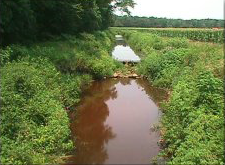Bay Habitats
 Stream health is generally in poor condition
Stream health is generally in poor condition
The majority of streams reveal poor habitat and water quality due to ditching, increased fertilizers (lawns, golf courses and farms) and septics that wash nutrients into the streams and bay. Some areas have seen improvements since 1977 (very poor to fair in upper St. Martin River)
Seagrass have experienced major declines since 2001
Seagrasses (technically known as Submerged Aquatic Vegetation, or SAV) provide essential nursery habitat for many ecologically, commercially, and recreationally important fish and shellfish. The total area of seagrass beds in 2015 was 8,743 acres (32% of goal), less than half of its peak in 2001 (19,301 acres).
Seagrass acreage decreased from 2014, with little to no bay grasses documented above Ocean City Inlet. Current acreage is 32% of the established goal. In 2001, seagrass acreage met 71% of the goal. The 2015 abundance is better than 2013 (the lowest seagrass acreage in 2 decades); however, elevated nutrients, high water temperatures, and prolific macroalgae (seaweeds) limited recovery. Water temperatures in some areas exceeded the seagrass temperature threshold of 30oC (86oF) over 600 hours (nearly 25 days) during the 2015 growing season.
Sinepuxent seagrass acreage was equal to 2014, however Chincoteague Bay lost 1,000 acres. Overall, Chincoteague Bay has lost nearly 9,000 acres of seagrass since 2001 (55% of its 2001 acreage). Seagrasses are critical fish habitat and support numerous species of juveniles.